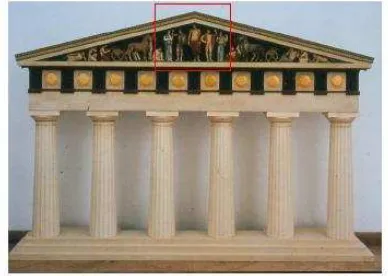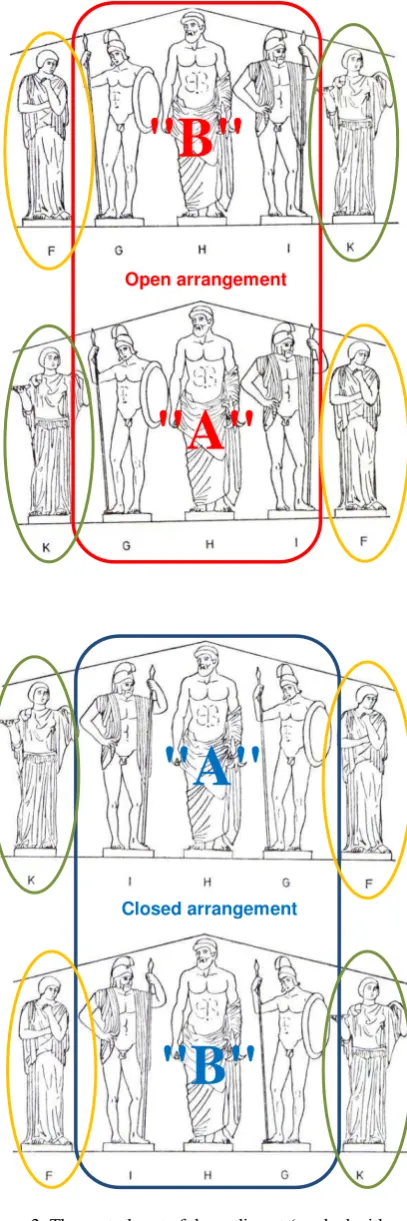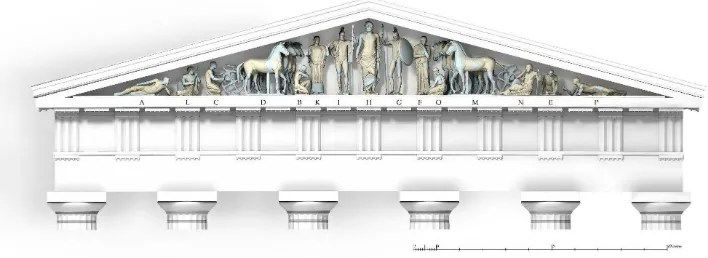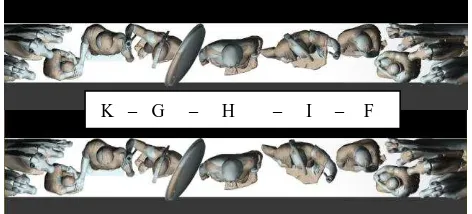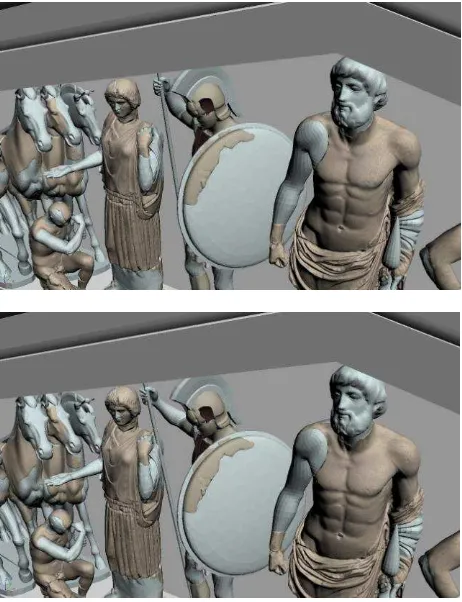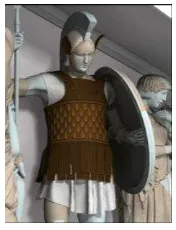THE COMPLETE VIRTUAL 3D RECONSTRUCTION OF THE EAST PEDIMENT OF
THE TEMPLE OF ZEUS AT OLYMPIA
A. Patay-Horváth
Archaeological Institute of the Hungarian Academy of Sciences -
Institute for Ancient History, University Eötvös
Loránd, Budapest, Hungary
- pathorv@gmail.com
KEY WORDS: Archaeology, ancient Greek art, marble sculpture, 3D scanning, innovative virtual modelling software
ABSTRACT:
The arrangement of the five central figures of the east pediment of the temple of Zeus at Olympia has been the subject of scholarly debates since the discovery of the fragments more than a century ago. In theory, there are four substantially different arrangements, all of which have already been selected by certain scholars for various aesthetic, technical and other considerations. The present project tries to approach this controversy in a new way, by producing a virtual 3D reconstruction of the group. Digital models of the statues were produced by scanning the original fragments and by reconstructing them virtually. For this purpose an innovative new software (Leonar3Do) has also been employed. The virtual model of the pediment surrounding the sculptures was prepared on the basis of the latest architectural studies and afterwards the reconstructed models were inse rted in this frame, in order to test the technical feasibility and aesthetic effects the four possible arrangements. The paper gives an overview of the entire work and presents the final results suggesting that two arrangements can be ruled out due to the limited space available in the pediment.
KURZFASSUNG:
Die Anordnung der fünf Mittelfiguren im Ostgiebel des Zeustempels von Olympia stellt immer noch ein ungelöstes Problem der klassischen Archäologie dar, obwohl die Fragmente schon im 19 Jh. ausgegraben wurden und seitdem intensiv erforscht werden. Theoretisch sind vier unterschiedliche Rekonstruktionen möglich und jede Lösung ist schon von mehreren Experten befürwortet und mit unterschiedlichen Argumenten gestützt worden. Das hier vorgestellte Projekt versucht die Kontroverse auf eine neue Art und Weise, durch eine virtuelle 3D Rekonstruktion zu lösen. Die erhaltenen Fragmente wurden gescannt und anschliessend virtuell ergänzt. Zu diesem Zweck wurde ein innovatives, neu entwickeltes software (Leonar3Do) verwendet. Der Giebel wurde den neuesten architektonischen Untersuchungen entsprechend ebenfalls virtuell rekonstruiert und die einzelnen Skulpturenmodel le wurden dann in diesen virtuellen Rahmen eingesetzt, um die technische Ausführbarkeit und die ästhetische Wirkung der ganzen Gruppe zu testen. Der Beitrag gibt einen Überblick von der gesamten Arbeit und präsentiert die Ergebnisse, die zum Schluss führen, dass zwei Anordnungen aus räumlichen Gründen mit grosser Wahrscheinlichkeit ausgeschlossen werden können.
1. INTRODUCTION
1.1 The subject
The temple of Zeus at Olympia was built in the first half of the 5th century B.C. (ca. 475–455). Its sculptural decoration consists of two pediments and twelve metopes. Given the large size of the building itself, the sculptures were all well over lifesize and were made of white parian marble. A large number of fragments survived which are conserved in the Archaeological Museum of Olympia and in the Musée du Louvre at Paris. Most of them are quite well preserved and are depicted in practically every handbook on Greek art or on ancient art in general, because nowadays they are generally considered to be one of the most important and most magnificent works of ancient Greek art.
The sculptures of the temple in general and the fragments of the east pediment in particular have been thoroughly studied since their discovery in the 1880’s, but they still pose some important questions, as indicated by the growing number of monographs and scholarly articles related to them (e.g. TREU 1897, ASHMOLE-YALOURIS 1967, SIMON 1968, SÄFLUND 1970, HERRMANN 1987, KYRIELEIS 1997,
BARRINGER 2005, REHAK – YOUNGER 2009). The most recent debate has started with a series of publications by the author (PATAY 2004, PATAY 2005, PATAY 2006, PATAY 2008) and concerns the interpretation of the east pediment (Figure 1), which involves the problematic issue of the correct reconstruction of this group as well.
Figure 1. Reconstructed plaster model (approx. scale 1:10) of the east front of the temple of Zeus at Olympia. Staatliche
Kunstsammlungen Dresden (Albertinum). Photo: author.
Figure 2. The central part of the pediment (marked with red in Figure 1) enlarged. Schematic reconstruction drawings showing every conceivable arrangement of the five central figures. Different colours highlight the differences of the four
versions. After Herrmann 1972.
1.2 The problem
The arrangement of the five central figures of the east pediment has been the subject of scholarly debates since the discovery of the fragments more than a century ago (HERRMANN 1987, PATAY 2008). The basic problem is that the fragments themselves can be arranged in four substantially different ways (Figure 2) and there are no obvious clues for choosing the most probable one. There is a fairly detailed description of the group by Pausanias, who saw it in the 2nd cent. AD, but his text (V 10, 6-7) is not conclusive regarding the precise arrangement of the figures (he does not specify how to understand his indications „to the left” and „tothe right” of the central figure). The findplaces are not unequivocal either, since the pieces were scattered around the temple by an earthquake in the 6th cent. AD and the fragments were subsequently reused in medieval buildings.
In sum, there are four different arrangements, all of which have already been advocated by certain scholars for various aesthetic, technical and other considerations. Most often the reconstructions were presented in simple drawings, ignoring the three-dimensional form of the statues and the results of the early experiments with life-size 3D plaster models are nowadays equally ignored. The most important result of these experiments was, that they were able to exclude at least one of the four possibilities, purely because of the lack of space. The renown German scholar, G. Treu stated explicitly (TREU 1897, 120), that figures G and K can not be placed next to each other in the southern part of the pediment, because their arms would come into collision. Obviously enough, after experimenting more than a decade with the models, he was absolutely convinced, that this arrangement is physically impossible and invited everybody to verify this statement with the life-size plaster models. This has been done by various scholars following him until 1939, and no one questioned this observation, even if some arrived at another arrangement, different from the one suggested by him. After the second world war, the models were totally inaccessible and the results of the early experiments are nowadays totally ignored: in recent publications they are practically not mentioned any more, and no one has attempted to verify or to refute them. This is all the more astonishing, because the arrangement (Open "A": K – G – H – I – F) , which has been condemned as impossible already
Since experimentation with the precious and monumental original fragments is out of question, plaster casts and models are expensive to produce and not easy to handle, it seemed to be reasonable to apply the latest 3D scanning technology to the problem. The aim of the project is to test the practical feasibility and aesthetic effects of the possible arrangements with 3D models of the reconstructed statues. The digital models were produced by scanning the original fragments and by reconstructing them (i.e. completing their missing limbs and armour) virtually.
Figure 3. The most commonly accepted reconstruction (open arrangement "A") of the pediment (after Herrmann 1972 fig. 95)
Figure 4. The new virtual reconstruction (closed arrangement "A") of the complete pediment
2.2 Data capture
The difficult task of scanning the monumental marble fragments was carried out in the Museum of Olympia from 23.08 to 03.09. 2009 by two experienced technicians of Tondo Ltd. (Budapest, Hungary) under the supervision of the project coordinator. A Breuckmann smartSCAN Duo structured light scanner has been used and 1150 scans were taken, amounting to ca. 57 GB. The difficulties encountered during the data capture are detailed in the preliminary report (PATAY 2010) and can be summarized as follows:
monumental scale (1,5-2 times lifesize) of the fragments, upper parts are accessible only with a special equipment (Jimmy Jib; Figure 5)
absolutely unmovable pieces: fastened to the wall with several massive iron bars, alignment close to the wall, rear sides difficult to reach with the scanner
world-famous pieces, highlights of the museum: restricted working hours from 8–12 p.m.
Figure 5. The scanner mounted on the Jimmy Jib in the Archaeological Museum of Olympia. Photo: author.
The difficulties were overcome in most cases very successfully and all the figures of the pediment (13 human figures and two four-horse chariot teams) were scanned in two weeks. Some rear parts, however, proved to be entirely inaccessible for the scanner. As these parts were in most cases only roughly hewn from the block, their exact rendering is actually irrelevant for the reconstruction. Moreover, they are sufficiently documented in drawings and photographs, and could therefore be approximately completed during the processing of the scans. (Cf. PATAY 2010)
2.3 Virtual modelling and reconstruction
The high-resolution models of the fragments were simplified by a radical decimating of their polygons in order to create models (each measuring approximately 150 000 polygons), which are easily manipulated, but in order to preserve their high artistic quality, normal maps were applied to their surfaces. For the completion of the missing parts (limbs, heads, armour, chariots) different software products have been tested (Bentley Microstation, Poser by SmithMicro, Leonard3Do by 3DforAll, Autodesk 3ds Max Studio) The most problematic issue was the completion of the missing arms, because their exact rendering and position is far from being certain.
Modelling was done by a sculptor (M. Hitter) and by an architect-designer (G. Gedei) independently from each other. Both were instructed and supervised by the author (a classical archaeologist) coordinating the project, in order to create models which are conform with the style of the original fragments (the so-called severe style, characteristic for the first half of the 5th century B.C.), but both of them used different softwares (Leonar3Do, Autodesk 3ds Max) and adopted different methods for the reconstruction of the missing parts. The resulting models were, however not substiantially different regarding their poses and their proportions. (Figure 6)
Figure 6. Two different reconstructions of figure G compared. (a): M. Hitter - Leonar3Do, (b): G. Gedei - 3D max.
According to the most recent architectural studies (GRUNAUER 1981) and partly parallel with the virtual reconstruction of the figures, the exact virtual 3D reconstruction of the pedimental frame was also created by G. Gedei (using ArchiCAD). The completed models of the statues were then inserted into this frame in order to test the feasibility and the aesthetic effects of each possible reconstruction. (Figure 4)
The reconstructions differ from each other not only regarding the sequence of the figures, but also in their poses and orientation. Every possible position was tested, including the different rotations of the figures. (Figure 7, 8) In addition, the outreaching arms of the two male protagonists were animated in order to test them in slightly different poses (Figure 9). These parts have almost totally perished but they are vital for the assessment of the different reconstructions.
Figure 7. The same arrangement (open “A”) with figure I turned away from the rear wall (above) and parallel to it
(below).
K – G – H – I – F
(a) (b) (a) + (b)
Figure 8. The same arrangement (closed “A”) with figure I turned away from the rear wall (left) and parallel to it (right).
Figure 9. Different poses of figure G. The position of the right arm holding a spear was tested by animating the model.
2.4 Results and discussion
The experimentation with the reconstructed models revealed that contrary to the expectations based on the results of the early experiments with plaster casts, every arrangement could be realized. (Figure 10) This result can not be due to the fact that the pediment was at that time reconstructed with slightly different (smaller) dimensions, because the same models placed in the virtual reconstruction of the pediment using the former, smaller dimensions yield the same result. The discrepancy is most probably caused by the different rendering of some figures and clearly needs further investigations.
Figure 10. Virtual 3D reconstructions of the central figures arranged as in Figure 2. The fragments are displayed in grey,
the reconstructed parts in pale blue
The model shows, however, that the arrangement, which was considered to be physically impossible in the 19th century (open “A”) and which is most commonly accepted today (Figure 3, 7), is indeed the most difficult to realize: the limbs of figure K and G do not necessarily run across each other, but the distance between them is so small (max. 10 cm) that we can hardly believe that this arrangement could follow the original intentions of the designers or the sculptors. (Figure 9, 11)
Figure 11. Figures K and G according to the open “A” arrangement
Furthermore, the model clearly shows that in the case of both open arrangements, another problem arises: the spears in the hands of the male figures fit the available space only if both of them grip the shaft directly under the spear-head (Figure 12), which is otherwise not attested in Greek art.
Figure 12. The spear-heads of the male figures in the open arrangement
In the case of closed arrangements, we have no such problem with the spears (Figure 13), these arrangements can therefore be regarded more probable than the open ones. Further archaeological considerations (Patay 2008) support the hypothesis that the closed “A” arrangement (Figure 4) should be considered as the most probable reconstruction.
Figure 13. The spear-heads of the male figures in the closed arrangement
3. CONCLUSIONS
The models enable easy and very instructive experimentation, which would be otherwise impossible with the originals and/or very expensive and not very effective with real-size plaster models.
The virtual 3D model of the whole pediment was used to verify the results of early experiments carried out with plaster models and proved to yield results, which are at this stage incompatible with those achieved previously.
The complete model can effectively be used to compare the aesthetic effects of the different reconstructions. One can e.g. easily adopt the viewpoint of a visitor standing in front of the temple and have a look at the model from below. (Figure 14)
The 3D models of the individual fragments can be used for further research and for visualization, e.g. one can proceed to reconstruct the lost metal attachments of the statues. (Figure 15)
Figure 14 The central figures of the pediment from the viewpoint of a visitor standing in front of the temple
Figure 15. Reconstruction of the lost metal attachments (cuirass and cheek-pieces) of figure G.
References
ASHMOLE, B. – YALOURIS, N., 1967. Olympia. The Sculptures of the Temple of Zeus. London: Phaidon.
BARRINGER, J. M., 2005. The Temple of Zeus at Olympia, Heroes and Athletes, Hesperia 74, pp. 211-241.
GRUNAUER, P., 1981 Zur Ostansicht des Zeustempels, in:
10. Bericht über die Ausgrabungen in Olympia. Frühjahr 1966
bis Dezember 1976. Berlin, pp. 256-301 of the Temple of Zeus at Olympia, in: Buitron-Oliver, D. (ed.) The Interpretation of Architectural Sculpture in Greece and Rome. Washington: National Gallery of Art.
PATAY-HORVÁTH, A., 2004 Pausanias und der Ostgiebel des Zeustempels von Olympia, Acta Antiqua Acad. Hung. 44 pp. 21-33.
PATAY-HORVÁTH, A., 2005 Die Frisur der weiblichen Protagonisten im Ostgiebel des Zeustempels von Olympia, in: Ganschow, Th., Steinhart, M. (eds.) Otium. Festschrift für Volker Michael Strocka. Remshalden: Greiner, pp. 275-283.
PATAY-HORVÁTH, A., 2006 The armor of Pelops, in: Mattusch, C. C., Donohue, A. A. , Brauer, A- (eds.) Common Ground. Archaeology, Art, Science and Humanities. Proceedings of the XVIth International Congress of Classical Archaeology Boston. Oxford:Oxbow, pp. 424-427.
PATAY-HORVÁTH, A., 2008 Zur Rekonstruktion und Interpretation des Ostgiebels des Zeustempels von Olympia, Mitteilungen des Deutschen Archäologischen Instituts, Athenische Abteilung 122, pp. 161-206.
PATAY-HORVÁTH, A., 2010 Virtual 3D Reconstruction of the East Pediment of the Temple of Zeus at Olympia – A Preliminary Report, Archeometriai Műhely / Archaeometry Workshop, 7/1 2010, 19-26.
SIMON, E., 1968 Zu den Giebeln des Zeustempels von Olympia Mitteilungen des Deutschen Archäologischen Instituts, Athenische Abteilung 83, pp. 147-167.
REHAK, P. – YOUNGER, J. G., 2009 Technical observations on the sculptures from the temple of Zeus at Olympia,
The scanning campaign was carried out with the permission of the 7th Ephorate of Prehistoric and Classical Antiquities in Greece and in close collaboration with the German Archaeological Institute at Athens, conducting the excavations on the site for more than 125 years. Special thanks are due to G. Hatzi (head of the Ephorate at Olympia) and R. Senff (archaeological supervisor of the Olympia excavations). Financial support for the project was provided by a joint research fund of the Norway Grants and the Hungarian National Research Fund (OTKA ref. no. NNF 78486) and the János Bolyai scholarship offered by the Hungarian Academy of Sciences.
